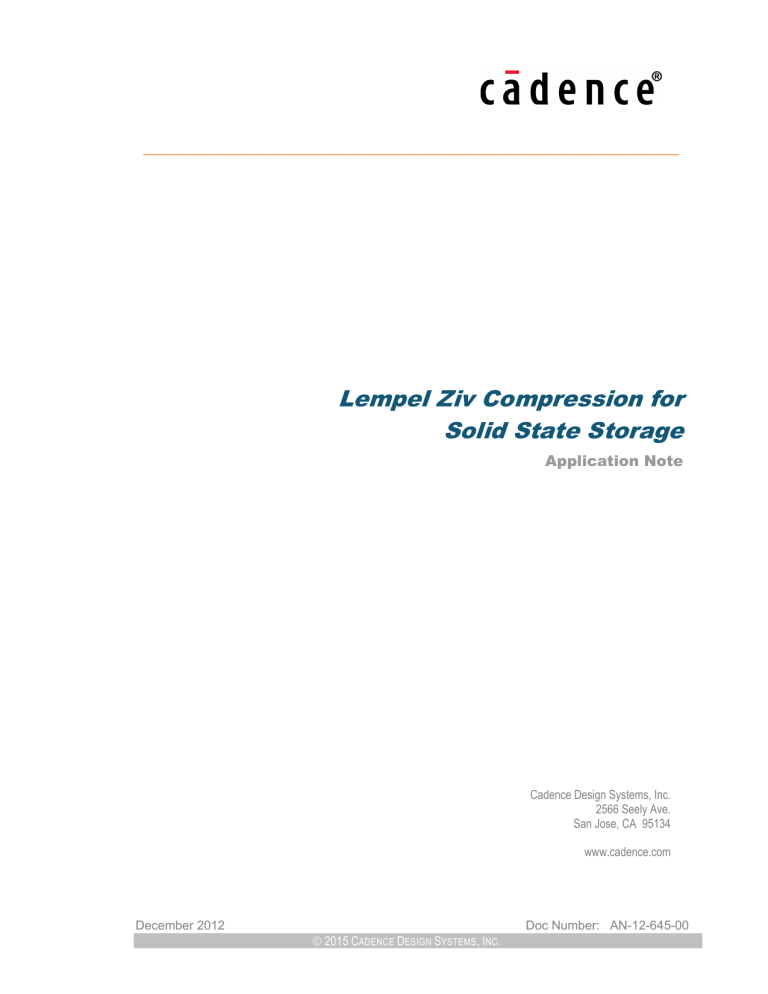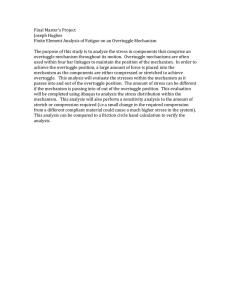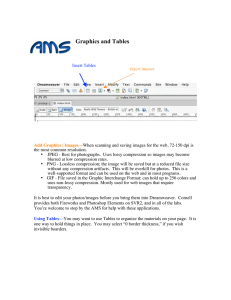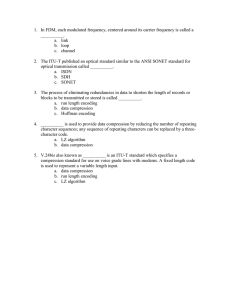
________________________________________________________
Lempel Ziv Compression for
Solid State Storage
Application Note
Cadence Design Systems, Inc.
2566 Seely Ave.
San Jose, CA 95134
www.cadence.com
December 2012
2015 CADENCE DESIGN SYSTEMS, INC.
Doc Number: AN-12-645-00
Lempel Ziv Compression for Solid State Storage
© 2015 Cadence Design Systems, Inc.
All rights reserved worldwide.
This publication is provided “AS IS.” Cadence Design Systems, Inc. (hereafter “Cadence") does not make any warranty of any kind, either expressed or implied,
including, but not limited to, the implied warranties of merchantability and fitness for a particular purpose. Information in this document is provided solely to enable
system and software developers to use our processors. Unless specifically set forth herein, there are no express or implied patent, copyright or any other
intellectual property rights or licenses granted hereunder to design or fabricate Cadence integrated circuits or integrated circuits based on the information in this
document. Cadence does not warrant that the contents of this publication, whether individually or as one or more groups, meets your requirements or that the
publication is error-free. This publication could include technical inaccuracies or typographical errors. Changes may be made to the information herein, and these
changes may be incorporated in new editions of this publication.
© 2014 Cadence, the Cadence logo, Allegro, Assura, Broadband Spice, CDNLIVE!, Celtic, Chipestimate.com, Conformal, Connections, Denali, Diva, Dracula,
Encounter, Flashpoint, FLIX, First Encounter, Incisive, Incyte, InstallScape, NanoRoute, NC-Verilog, OrCAD, OSKit, Palladium, PowerForward, PowerSI, PSpice,
Purespec, Puresuite, Quickcycles, SignalStorm, Sigrity, SKILL, SoC Encounter, SourceLink, Spectre, Specman, Specman-Elite, SpeedBridge, Stars & Strikes,
Tensilica, TripleCheck, TurboXim, Vectra, Virtuoso, VoltageStorm, Xplorer, Xtensa, and Xtreme are either trademarks or registered trademarks of Cadence Design
Systems, Inc. in the United States and/or other jurisdictions. All other trademarks are the property of their respective holders.
OSCI, SystemC, Open SystemC, Open SystemC Initiative, and SystemC Initiative are registered trademarks of Open SystemC Initiative, Inc. in the United
States and other countries and are used with permission.
Document Change History:
Published November 2012
November 2015 reformatted
ii
2015 CADENCE DESIGN SYSTEMS, INC.
Lempel Ziv Compression for Solid State Storage
Contents
1. Introduction ................................................................................................................................. 1
2. Lempel Ziv (LZ) Algorithms......................................................................................................... 2
2.1
LZ77 Algorithms............................................................................................................................. 2
2.2
LZSS Algorithms ............................................................................................................................ 2
3. LZSS Implementations ............................................................................................................... 3
3.1
Decoding / Decompression ............................................................................................................ 3
3.2
Encoding / Compression ................................................................................................................ 3
4. Compression using the Brute Force Approach ........................................................................... 4
4.1
Analysis and Profiling .................................................................................................................... 4
4.2
TIE Implementation........................................................................................................................ 5
4.2.1 Searching for the Next Match in the Sliding Window ........................................................ 6
4.2.2 Circular Buffer Wrapping ................................................................................................. 8
4.2.3 Get Next Char in Window with Wrapping ......................................................................... 9
4.2.4 Increment the Number of Matches with Max Limit .......................................................... 10
4.2.5 Advance the Starting Position for FindMatch in the Sliding Window .............................. 11
4.3
Updated ‘C’ Source Code ............................................................................................................ 12
5. Compression using the Hash Table Approach ......................................................................... 14
6. Conclusions .............................................................................................................................. 15
7. Appendix .................................................................................................................................. 17
7.1
The LZSS Xplorer Workspace ..................................................................................................... 17
Tables
Table 1. Profiled Code Results ....................................................................................................................... 4
Table 2. Profile Comparison ........................................................................................................................ 13
iii
2015 CADENCE DESIGN SYSTEMS, INC.
Lempel Ziv Compression for Solid State Storage
iv
2015 CADENCE DESIGN SYSTEMS, INC.
Lempel Ziv Compression for Solid State Storage
Abstract
Data compression is a key feature of Solid State Disk Drive (SSD) controller designs. For
most SSD controller applications, the high data throughput rates and resulting high
computational requirements of the data compression algorithms typically dictate that the
compression function be implemented in a dedicated hardware block in the controller System
on Chip (SOC) design. The downsides of dedicated hardware compression blocks include
(a) inflexibility (non-programmability) which limits the range of SSD applications in which a
single controller design can be used, and (b) high development risk associated with
implementing complex algorithms purely in finite state machines. The high risk and low range
of applicable usage for a hardware-based approach to SSD Controller design often leads to
unacceptable project return on investment (ROI).
This application note illustrates an alternative design approach – the use of customized,
optimized Xtensa dataplane processors (DPUs) that are specifically tuned to both the
algorithmic and data throughput requirements of compression functions for SSD controller
SOCs. With customized Xtensa DPUs it is possible to implement not only the compression
functionality but also many other SSD dataplane functions in programmable DPUs, a
methodology alternative that decreases SOC design time, decreases SOC verification efforts,
and provides post-silicon flexibility. Lower design costs plus greater re-use of the SOC design
in multiple SSD drive products can lead to dramatically better ROI.
This document provides a data point to illustrate this concept, showing an implementation of
LZ77 data compression optimization improved by 550% (compared to a baseline 3-issue
VLIW Xtensa CPU configuration) with a small added silicon area of only 16.5 kGates.
Note: The baseline Xtensa configuration, the Diamond Standard 570T controller CPU is
comparable in general application performance to other high-end, real-time controller CPU
designs on the market today.
Note that this illustration does not represent the maximum data compression performance
possible in a single Xtensa core. Significantly higher levels of performance are attainable
through the use of additional parallelization of the computation load and through aggressive
use of Tensilica’s patented unconventional designer-defined I/O data streams. The specific
optimization illustrated in this application note is kept to the lower-end of possible
acceleration to aid in your quick comprehension, and is designed to illustrate the concepts of
compression algorithm acceleration without the complexity of instruction parallelism (VLIW
techniques employing the Xtensa FLIX instruction feature) or data parallelism using SIMD
techniques. Your Cadence applications engineer will gladly assist you in exploring how these
more aggressive techniques can be applied to your specific SSD compression algorithmic
requirements.
In addition to this document, an associated Tensilica software development tools workspace
for the Xtensa Xplorer GUI development environment is available that includes source code
for all examples cited herein. Please contact your local Cadence sales office for access to
the example code workspace or view the appendix for details.
v
2015 CADENCE DESIGN SYSTEMS, INC.
Lempel Ziv Compression for Solid State Storage
vi
2015 CADENCE DESIGN SYSTEMS, INC.
Lempel Ziv Compression for Solid State Storage
1. Introduction
Data compression is commonly used to increase the effective storage capacity of devices. For
Flash storage, data compression has the added benefit of reducing Write Amplification –the extra
data that has to be written because whole blocks must be written even when only a few bytes of
data are actually changed.
This document briefly describes the Lempel Ziv compression techniques and shows how the
LZSS variant can be implemented very efficiently on an Xtensa DPU using Tensilica’s instruction
customization capability, the Tensilica Instruction Extension (TIE) language and methodology.
2015 CADENCE DESIGN SYSTEMS, INC.
1
Lempel Ziv Compression for Solid State Storage
2. Lempel Ziv (LZ) Algorithms
This section contains information from the Wikipedia article :
http://en.wikipedia.org/wiki/LZ77_and_LZ78
and from Michael Dipperstein’s LZSS site:
http://michael.dipperstein.com/lzss/
There are many variants of LZ algorithms, which all work by parsing the input sequence into
distinct phrases. Each phrase is encoded by reference to some previous phrase and perhaps
some additional information. This exploits redundancy that might exist in the input sequence.
2.1 LZ77 Algorithms
LZ77 algorithms achieve compression by replacing repeated occurrences of data with references
to a single copy of that data existing earlier in the input (uncompressed) data stream. A match is
encoded by a pair of numbers called a length-distance pair, which is equivalent to the statement
"each of the next length characters is equal to the characters exactly distance characters behind
it in the uncompressed stream". (The "distance" is sometimes called the "offset" instead.)
To spot matches, the encoder must keep track of some amount of the most recent data, such as
the last 2 kB, 4 kB, or 32 kB. The structure in which this data is held is called a sliding window,
which is why LZ77 is sometimes called sliding window compression. The encoder needs to
keep this data to look for matches, and the decoder needs to keep this data to interpret the
matches the encoder refers to. The larger the sliding window is, the longer back the encoder may
search for creating references.
It is not only acceptable, but also frequently useful to allow length-distance pairs to specify a
length that actually exceeds the distance. Tackling one byte at a time, there is no problem serving
this request, because as a byte is copied over, it may be fed again as input to the copy command.
When the copy-from position makes it to the initial destination position, it is consequently fed data
that was pasted from the beginning of the copy-from position. The operation is thus equivalent to
the statement "copy the data you were given and repetitively paste it until it fits". As this type of
pair repeats a single copy of data multiple times, it can be used to incorporate a flexible and easy
form of run-length encoding.
2.2 LZSS Algorithms
In their original LZ77 algorithm, Lempel and Ziv proposed that all strings be encoded as a length
and offset, even strings with no match. Storer and Szymanski observed that individual unmatched
symbols or matched strings of one or two symbols take up more space to encode than they do to
leave uncoded.
For example, encoding a string from a dictionary of 4096 symbols, and allowing for matches of up
to 15 symbols, requires 16 bits to store an offset and a length. A single character is only 8 bits.
Using this method, encoding a single character doubles the required storage.
Storer and Szymanski proposed preceding each symbol with a coded/uncoded flag. Using the
above example it now takes 9 bits for each uncoded symbol and 17 bits for each encoded string.
Storer and Szymanski also observed that if you are not encoding strings of length 0 to M, then M
may be used as an offset to the length of the match. Applying this observation, instead of using 4
bits to represent match lengths of 0 to 15, the same 4 bits may be used to represent match
lengths of M to (15 +M).
2
2015 CADENCE DESIGN SYSTEMS, INC.
Lempel Ziv Compression for Solid State Storage
3. LZSS Implementations
This document uses and presents parts of the “LZSS” library from Michael Dipperstein that can
be found at http://michael.dipperstein.com/lzss/, available under the GNU Lesser General Public
License.
3.1 Decoding / Decompression
Decoding an LZSS compressed file is fairly straightforward and thus is not illustrated in this
document. The source code for decoding is included in the associated Xplorer Workspace.
3.2 Encoding / Compression
There are a couple of common ways to implement the sliding window search function (called
FindMatch in the reference code). This is the function that searches the sliding window for a
match and is what takes up the most time.
Which approach to use usually depends on whether additional memory can be used to store a
hash table or not. The following section explains how the Brute Force approach (no use of local
memory storage) as well as the hash table approach (using additional memory) can be
implemented with Xtensa processors.
2015 CADENCE DESIGN SYSTEMS, INC.
3
Lempel Ziv Compression for Solid State Storage
4. Compression using the Brute Force Approach
The brute force approach is comparable to methods employed when built as a stand-alone RTL
accelerator.
This brute force method does not require the use of any additional memory, but takes more
cycles. For more information, see the file called brute.c in the reference code.
4.1 Analysis and Profiling
Starting with the original reference C code for brute, we profiled the code running on the
reference Diamond Standard 570T CPU. Our profile results show the following (XCC compiler
flags: -O2 –g):
TABLE 1. PROFILED CODE RESULTS
Function
Total
FindMatch
EncodeLZSSByFile
fgetc
DecodeLZSSByFile
BitFilePutBit
BitFileGetBit
Cycles (% of all)
55,956,903 (100%)
55,067,020 (98.4%)
130,773 (0.23%)
121,621 (0.21%)
111,926 (0.20%)
57,986 (0.10%)
45,894 (0.08%)
The FindMatch function consumes the vast majority of the cycles and is where we focused our
acceleration.
The FindMatch() function is shown below for reference. The full source code is available in the
accompanying Xplorer Workspace (the TIE additions are removed to simplify the display here)..
FindMatch() function Reference ‘C’ Source Code:
/****************************************************************************
*
Function
: FindMatch
*
Description: This function will search through the slidingWindow
*
dictionary for the longest sequence matching the MAX_CODED
*
long string stored in uncodedLookahed.
*
Parameters : windowHead - head of sliding window
*
uncodedHead - head of uncoded lookahead buffer
*
Effects
: None
*
Returned
: The sliding window index where the match starts and the
*
length of the match. If there is no match a length of
*
zero will be returned.
****************************************************************************/
encoded_string_t FindMatch(unsigned int windowHead, unsigned int uncodedHead) {
encoded_string_t matchData; // Contiguous matches and window offset
unsigned int wp,
// Window position
nm,
// Number of continguous matches
wIndex, wData,
// Sliding Window index and char data
uIndex, uData;
// Uncoded Head index and char data
unsigned char ucodedHead;
// Beginning of the uncoded data
4
2015 CADENCE DESIGN SYSTEMS, INC.
Lempel Ziv Compression for Solid State Storage
// 1. Initializations
matchData.length = nm = 0;
// No matches
matchData.offset = 0;
// At start
wp = windowHead;
// Set to beginning of sliding window
ucodedHead = uncodedLookahead[uncodedHead];
/*
* 2. Find the longest sequence that matches the uncoded data
* within the sliding window.
*/
while(TRUE) {
// Is next byte a match?
if(slidingWindow[wp] == uncodedHead /*uncodedLookahead[uncodedHead]*/) {
// 3. We matched one - find further contiguous matches
nm = 1;
// Initialize to one match
while(TRUE) {
// 4a. Next indices in sliding window and uncoded data
wIndex = Wrap((wp + nm), WINDOW_SIZE);
uIndex = Wrap((uncodedHead + nm), MAX_CODED);
wData = slidingWindow[wIndex];
uData = uncodedLookahead[uIndex];
if(wData != uData) break;
}
// Next window char
// Next uncoded char
// No match, exit inner loop
// 5a. Increment number of matches
if(nm >= MAX_CODED) break; // Over limit, exit inner loop
nm++;
// Matched - increment counter
// 6. Is the last match sequence the longest yet?
if(nm > matchData.length) {
// Yes, update
matchData.length = nm;
matchData.offset = wp;
}
}
// 7. Set up to start at the next point in the sliding window
if(nm >= MAX_CODED) {
// Over limit?
matchData.length = MAX_CODED;
// All chars matched
break;
// Exit outer loop
}
// 8a. Increment wp for starting at next location in window
wp = Wrap((wp + 1), WINDOW_SIZE); // Increment
if(wp == windowHead) break;
// At start, exit outer loop
}
}
return matchData;
// Contains the longest matching sequence and offset
4.2 TIE Implementation
Following are the areas that were studied and implemented in TIE for this document:
♦
Searching for the next match in the sliding window
♦
Wrapping a circular buffer
2015 CADENCE DESIGN SYSTEMS, INC.
5
Lempel Ziv Compression for Solid State Storage
♦
Getting the next character in window with wrapping
♦
Incrementing the number of matches with maximum limit
♦
Advancing the starting position for FindMatch in the sliding window
4.2.1 Searching for the Next Match in the Sliding
Window
From the reference ‘C’ code:
while(TRUE) {
// 2a. Is next byte a match?
if(slidingWindow[wp] == uncodedHead /*uncodedLookahead[uncodedHead]*/) {
}
// 3. We matched one - find further contiguous matches
.
.
.
This compares each byte in the sliding window with the uncoded byte until it finds a match.
The resulting assembly code (DC_570T, -O2), which requires 6 cycles looks like the following:
60002549:
6000254c:
6000254e:
60002551:
loop
a0, 600025bf
add.n
a9, a7, a12
l8ui
a9, a9, 0
bne a9, a15, 60002598
60002554: movi.n a6, 1
This performs a single byte read, yet most processors load at least 4 bytes at a time as a 32-bit
word. This can be optimized to compare each of the word’s 4 bytes in turn after a single load.
This reduces the number of loads considerably, but adds complexity in the comparison as one
has to deal with unaligned bytes in the word, and find the first byte that matches. Replicating the
byte four times into a word, comparing the whole word and then finding the first one still takes
many cycles and may not end up saving many cycles.
With an Xtensa processor, we add TIE to do the comparison of multiple bytes and update the
window pointer to the first one that matched in a single cycle, as follows:
/* -------------------------------------------------------------------------* Sliding window read and compare
*
Read multiple bytes (characters) at once and compare (4 bytes in this
example)
*
If match is found:
*
stop reading
*
update the window pointer to the first matched byte position
*
Otherwise
*
update the window pointer to one byte before next position to be read
*
*/
operation SlidingRead
{out BR match, inout AR wp, in AR *slidingwindow, in AR ucodedHead}
{out VAddr, in MemDataIn32, in WINDOWSIZE, inout NUMMATCHES}
{
wire [31:0] addr = slidingwindow + wp;
wire [1:0] align = addr[1:0];
// 1. Fetch the next 4 bytes
6
2015 CADENCE DESIGN SYSTEMS, INC.
Lempel Ziv Compression for Solid State Storage
assign VAddr = {addr[31:2], 2'b00}; // 32-bit aligned
wire [31:0] data = MemDataIn32;
// 2. Alignment
wire align0 = (align
wire align1 = (align
wire align2 = (align
wire align3 = (align
==
==
==
==
2'b00);
2'b01);
2'b10);
2'b11);
// 3. Compare data
wire b0match = ucodedHead[7:0] == data[7:0];
wire b1match = ucodedHead[7:0] == data[15:8];
wire b2match = ucodedHead[7:0] == data[23:16];
wire b3match = ucodedHead[7:0] == data[31:24];
wire [3:0] bmatch = {b3match, b2match, b1match, b0match};
// 4. For
wire top1
wire top2
wire top3
each byte position, is it at the
= (wp == WINDOWSIZE);
= ((wp+32'd1) == WINDOWSIZE);
= ((wp+32'd2) == WINDOWSIZE);
end of the window?
// Last byte
// 2 bytes from end
// 3 bytes from end
// 5. Set valid bitmask for bytes that should be compared per alignment
wire [3:0] v0 = top1 ?
4'b0001:
top2 ?
4'b0011:
top3 ?
4'b0111:
4'b1111;
wire [3:0] v1 = top1 ?
4'b0010:
top2 ?
4'b0110:
4'b1110;
wire [3:0] v2 = top1 ?
4'b0100:
4'b1100;
wire [3:0] v3 =
4'b1000;
// 6. Compare just the bytes that are valid for this alignment
wire [3:0] valid = TIEsel(align0, v0, align1, v1, align2, v2, align3, v3);
wire [3:0] validmatch = bmatch & valid;
// 7. Was there a match?
assign match = (validmatch != 4'b0);
assign NUMMATCHES = (validmatch != 4'b0) ? 1 : NUMMATCHES;
// 8. Calculate extra increment for wp (1 is added by default in caller)
// - set increment for each alignment in inc0 thru inc3.
// - prevent wrapping over end using topN
wire [2:0] inc0 = (validmatch[0] | top1) ?
3'b000:
(validmatch[1] | top2) ?
3'b001:
(validmatch[2] | top3) ?
3'b010:
3'b011;
wire [2:0] inc1 = (validmatch[1] | top1) ?
3'b000:
(validmatch[2] | top2) ?
3'b001:
3'b010;
wire [2:0] inc2 = (validmatch[2] | top1) ?
3'b000:
3'b001;
wire [2:0] inc3 =
3'b000;
// 9. Set the increment for the current alignment
wire [2:0] wpinc = TIEsel(
align0, inc0, align1, inc1,
align2, inc2, align3, inc3);
wire [31:0] wpinc32 = {29'b0, wpinc};
}
assign wp = wp + wpinc32; // Increment
2015 CADENCE DESIGN SYSTEMS, INC.
7
Lempel Ziv Compression for Solid State Storage
The multiple-line complexity shown in Sections 5 and 7 of the code is for dealing with the four
possible alignments of the current position of the byte pointer wp.
The updated ‘C’ source code is:
while(TRUE) {
// 2b. Find first match
SlidingRead(matchb, wp,
if (matchb) { // One of
// 3. We matched one .
.
.
}
to uncoded head in next group of window bytes
&slidingWindow, ucodedHead);
the bytes matched, wp points to matched byte
find further contiguous matches
The Xplorer workspace shows this 32-bit example, as well as a version that reads 64 bits at a
time for even fewer cycles when wider loads are configured. Note that the Xtensa processor can
be configured with Load/Store units up to 512 bits wide. Thus the acceleration examples shown
here (32 bits) can easily be scaled by an additional factor of 16x.
4.2.2 Circular Buffer Wrapping
There are two circular buffers in this implementation. One for the input character stream being
compressed and the other for the sliding window holding previously compressed input data.
These buffers can be of different lengths and are accessed frequently during the compression.
The macro for the “Wrap” function is as follows:
Wrap(value, limit)
(((value) < (limit)) ? (value) : ((value) - (limit)))
This results in the following assembler instruction sequence (DC_570T, -O2):
60002598: { addi a9, a7, 1; bltu.w18
a11, a6, 600025a8 <FindMatch+0x80> }
600025a0: bltu
a8, a9, 600025b2 <FindMatch+0x8a>
600025a3: j 600025b7 <FindMatch+0x8f>
600025a6 <FindMatch+0x7e>:
...
600025a8 <FindMatch+0x80>:
600025a8: { l32i a2, a1, 0; movi
600025b0: retw.n
a3, 18; nop }
600025b2 <FindMatch+0x8a>:
600025b2: l32r
a9, 6000192c <_stext+0x54>
600025b5: add.n a9, a7, a9
600025b7: { mov.n
a7, a9; beq.w18
a9, a2, 600025c8 <FindMatch+0xa0> }
600025bf <FindMatch+0x97>:
600025bf: j 60002549 <FindMatch+0x21>
This can take 2 to 4 cycles to execute on a traditional processor. With the addition of a custom
instruction, this can be done in a single cycle with an Xtensa processor.
We created a general purpose TIE function that can be used for wrapping to different buffer
lengths – this is called by the L8Wrap and IncWP operations (shown in the following sections of
this application note).
The TIE code is shown as follows:
8
2015 CADENCE DESIGN SYSTEMS, INC.
Lempel Ziv Compression for Solid State Storage
/* ----------------------------------------------------------------------* Add offset to base and wrap them if over the boundary (circular buffer)
*
* result == (base + offset) % wlen
*/
function [31:0] wrap ([31:0] base, [31:0] offset, [31:0] wlen) shared
{
wire [31:0] tmp = base + offset;
wire [31:0] newOffset = (tmp < wlen)? tmp : tmp - wlen;
assign wrap = newOffset;
}
This is called using the “Wrap” intrinsic, as shown in the updated source code in the following
sections of this application note.
4.2.3 Get Next Char in Window with Wrapping
The reference ‘C’ source code:
// 4a. Next indices in sliding window and uncoded data
wIndex = Wrap((wp + nm), WINDOW_SIZE);
uIndex = Wrap((uncodedHead + nm), MAX_CODED);
wData = slidingWindow[wIndex];
uData = uncodedLookahead[uIndex];
// Next window char
// Next uncoded char
produces the following assembly code (DC_570T; -O2) that consumes 4 to 8 cycles:
6000255e: add.n a9, a7, a6
60002560: { mov.n
a10, a9; bltu.w18 a8, a9, 6000256b <FindMatch+0x3b> }
60002568: j 6000256e <FindMatch+0x3e>
6000256b <FindMatch+0x3b>:
6000256b: addmi a10, a9, 0xfffff000
6000256e: { add a9, a3, a6; add
60002576: { l8ui a4, a4, 0; bgeu.w18
6000257e: addi
a4, a10, a12; nop }
a11, a9, 60002581 <FindMatch+0x51> }
a9, a9, -18
For each of the sliding window and uncoded data, this code calculates a wrapped index with the
same offset (nm) into the different circular buffers using a common macro “Wrap” and then gets
the data at that index.
Here is the single-cycle TIE implementation that does the offset, wrapping and returning of the
data for one circular buffer. In this case, the common offset “nm” is stored in a state register
“NUMMATCHES” and thus is not an explicit operand of the L8Wrap function.
/* -------------------------------------------------------------------------* Load next char (8 bits) from wrapped offset to circular buffer base (addr)
* This takes an isSlidingWindow parameter to determine the wrap point
*
* Effect:
* limit = WINDOWSIZE if isSlidingWindow, otherwise MAXCODED
* data = addr[ (index+NUMMATCHES)%limit ]
*/
operation L8Wrap {out AR data, in AR *addr, in AR index, in SW
isSlidingWindow}
{in WINDOWSIZE, in MAXCODED, in NUMMATCHES, out VAddr, in MemDataIn8}
{
wire [31:0] limit = isSlidingWindow ? WINDOWSIZE : MAXCODED;
2015 CADENCE DESIGN SYSTEMS, INC.
9
Lempel Ziv Compression for Solid State Storage
wire [31:0] offset = wrap(index, NUMMATCHES, limit); // Add with wrap
wire [31:0] memaddr = addr + offset;
// Offset into the buffer
assign VAddr = memaddr;
// Issue the data fetch
}
assign data = {24'b0, MemDataIn8};
// Fetched data
The new ‘C’ source code to replace the reference code is:
wData = L8Wrap(&slidingWindow[0], wp, 1);
uData = L8Wrap(&uncodedLookahead[0], uncodedHead, 0);
This updated source code produces the following assembly code (DC_570T + TIE) that now
consumes only 2 cycles:
60002598: l8wrap a4, a8, a3, 0
6000259b: l8wrap a15, a7, a6, 1
4.2.4 Increment the Number of Matches with Max Limit
The Reference ‘C’ source code:
// 5a. Increment number of matches
if(nm >= MAX_CODED) break; // Over limit, exit inner loop
nm++;
// Matched - increment counter
produces the following assembly code (DC_570T; -O2):
60002589: bltu
a11, a6, 60002595
6000258c: { addi a6, a6, 1; j
6000255e
This requires 5 cycles in the case where the limit is reached and 3 cycles if nm is incremented.
Here is the single-cycle TIE code that increments up to the MAXCODED limit:
/* ------------------------------------------------------------------------* Increment the number of matches, up to the MAXCODED limit
*/
operation IncNUMMATCHES {out BR exit}
{in MAXCODED, inout NUMMATCHES}
{
wire limit = NUMMATCHES >= MAXCODED;
// At/over the limit?
assign NUMMATCHES = NUMMATCHES + 32'b1; // Increment
assign NUMMATCHES_kill = limit;
// Don't inc if over/at limit
assign exit = NUMMATCHES >= MAXCODED;
// Return the exit status
}
In the new source ‘C’ code:
// 5b. Increment NUMMATCHES state unless over MAX_CODED limit
done = IncNUMMATCHES();
// Sets done if over limit
if (done) break;
// Exit inner loop when over limit
}
the updated source code now produces the following assembly code (570T + TIE) that only
consumes 1 to 3 cycles:
6000259e: incnummatches b2, a15, a4
600025a1: bt
b2, 6000257b <FindMatch+0x2b>
10
2015 CADENCE DESIGN SYSTEMS, INC.
Lempel Ziv Compression for Solid State Storage
4.2.5 Advance the Starting Position for FindMatch
in the Sliding Window
The reference source code:
// 7. Set up to start at the next
if(nm >= MAX_CODED) {
matchData.length = MAX_CODED;
break;
}
point in the sliding window
// Over limit?
// All chars matched
// Exit outer loop
has a similar performance to the previously optimized code, taking 3 to 5 cycles.
The TIE code:
/* ------------------------------------------------------------------------* Increment circular window position (wp) with wrapping
* Don't increment if reached coding limit or wrapped to beginning (windowHead)
*
* Effect:
* if((wp+1)!=windowHead && NUMMATCHES<MAXCODED) {
*
wp = wp + 1;
*
exit = false;
* } else {
*
if(NUMMATCHES>MAXCODED) nm = MAXCODED;
*
exit = true;
* }
*/
operation IncWP {out AR nm, out BR exit, inout AR wp, in AR windowHead}
{in WINDOWSIZE, in NUMMATCHES, in MAXCODED, inout WRAPAROUND}
{
// 1. Set earlyexit if we've reached the encoding limit
wire earlyexit = NUMMATCHES >= MAXCODED;
assign nm = MAXCODED;
assign nm_kill = ~earlyexit; // Don't update nm if we're not exiting
// 2. Increment index and wrap over end of search window
wire [31:0] next = wrap(wp, 32'b1, WINDOWSIZE);
assign wp = next;
assign wp_kill = earlyexit; // Don't update wp if we need to exit
// 3. Detect wraparound but keep current state in case already wrapped
wire nextwrap = (next == 32’b0) ? 1’b1 : WRAPAROUND
assign WRAPAROUND = nextwrap;
// 4. Set exit if past end of search window or reached max encoding limit
assign exit = (next==windowHead) | (nextwrap & (next>windowHead)) |
earlyexit;
}
produces new ‘C’ source code as follows that only requires 1 to 3 cycles:
// 7. Set up to start at the next point in the sliding window
// 8b. Increment wp with window wrap, set done if wrapped to start
IncWP(matchData.length, done, wp, windowHead);
if(done) break;
// At start, exit outer loop
2015 CADENCE DESIGN SYSTEMS, INC.
11
Lempel Ziv Compression for Solid State Storage
4.3 Updated ‘C’ Source Code
Following is the new ‘C’ Source Code reflecting all previous changes in this section:
/****************************************************************************
*
Function
: FindMatch
*
Description: This function will search through the slidingWindow
*
dictionary for the longest sequence matching the MAX_CODED
*
long string stored in uncodedLookahed.
*
Parameters : windowHead - head of sliding window
*
uncodedHead - head of uncoded lookahead buffer
*
Effects
: None
*
Returned
: The sliding window index where the match starts and the
*
length of the match. If there is no match a length of
*
zero will be returned.
****************************************************************************/
encoded_string_t FindMatch(unsigned int windowHead, unsigned int uncodedHead) {
encoded_string_t matchData; // Contiguous matches and window offset
unsigned int wp,
// Window position
nm,
// Number of continguous matches
wIndex, wData,
// Sliding Window index and char data
uIndex, uData;
// Uncoded Head index and char data
unsigned char ucodedHead;
// Beginning of the uncoded data
// 1. Initializations
matchData.length = nm = 0;
// No matches
matchData.offset = 0;
// At start
wp = windowHead;
// Set to beginning of sliding window
ucodedHead = uncodedLookahead[uncodedHead];
xtbool done;
// Used to early-terminate loops
xtbool matchb;
// Used to identify any matched bytes
// State registers
WUR_WINDOWSIZE(WINDOW_SIZE);
WUR_MAXCODED(MAX_CODED);
WUR_NUMMATCHES(nm);
WUR_WRAPAROUND(0);
/*
* 2. Find the longest sequence that matches the uncoded data
* within the sliding window.
*/
while(TRUE) {
// 2b. Find first match to uncoded head in next group of window bytes
SlidingRead(matchb, wp, &slidingWindow, ucodedHead);
if(matchb) {
// 3. We matched one - find further contiguous matches
while (TRUE) {
// 4b. Next char in sliding window and uncoded data
// L8Wrap adds the NUMMATCHES state to get the address
wData = L8Wrap(&slidingWindow[0], wp, 1);
uData = L8Wrap(&uncodedLookahead[0], uncodedHead, 0);
////if (wData != uData) break;
// No match, exit inner loop
// 5b. Increment NUMMATCHES state unless over MAX_CODED limit
done = IncNUMMATCHES ();
// Sets done if over limit
if (done) break;
// Exit inner loop when over limit
}
nm = RUR_NUMMATCHES();
// Number of matches from state
12
2015 CADENCE DESIGN SYSTEMS, INC.
Lempel Ziv Compression for Solid State Storage
}
// 6. Is the last match sequence the longest yet?
if(nm > matchData.length) {
// Yes, update
matchData.length = nm;
matchData.offset = wp;
}
// 7. Set up to start at the next point in the sliding window
// 8b. Increment wp with window wrap, set done if wrapped to start
IncWP(matchData.length, done, wp, windowHead);
if (done) break;
// At start, exit outer loop
}
}
return matchData; // Contains the longest matching sequence and offset
The LZSS workspace includes the whole code with conditional #define’s for running the original
or TIE instructions.
The following table shows the profile comparison with all changes discussed previously in this
section (XCC compiler option: -O2 -g):
TABLE 2. PROFILE COMPARISON
Cycle
Count
Total
FindMatch
DC_570T
(Reference Core)
55,956,903
55,067,020
DC_570T
(with TIE 15.6 kGates)
10,800,786
9,909,137
Differences
5.1x
5.6x
As Table 2 shows, the FindMatch function is accelerated about 5.6x and the overall algorithm by
over 5x.
2015 CADENCE DESIGN SYSTEMS, INC.
13
Lempel Ziv Compression for Solid State Storage
5. Compression using the Hash Table Approach
This approach is typically used when implementing this algorithm on a processor.
This approach uses a hash table to reduce time searching the window for matching sequences.
This approach requires the use of memory to store the tables, but is faster than the Hardware
(brute force) approach discussed in Section 4.
This document uses and presents parts of the “LZSS” library from Michael Dipperstein that can
be found at: http://michael.dipperstein.com/lzss/, available under the GNU Lesser General Public
License.
The hash-based implementation of LZSS compression still requires a sliding window search as
discussed previously in this document. Following is the source code for FindMatch using a hashbased approach:
encoded_string_t FindMatch(unsigned int windowHead, unsigned int uncodedHead) {
encoded_string_t matchData;
unsigned int i, j;
matchData.length = 0;
matchData.offset = 0;
i = hashTable[HashKey(uncodedHead, TRUE)];
j = 0;
while (i != NULL_INDEX) {
if (slidingWindow[i] == uncodedLookahead[uncodedHead]) {
/* we matched one how many more match? */
j = 1;
while(slidingWindow[Wrap((i + j), WINDOW_SIZE)] ==
uncodedLookahead[Wrap((uncodedHead + j),MAX_CODED)]) {
if (j >= MAX_CODED) {
break;
}
j++;
}
if (j > matchData.length) {
matchData.length = j;
matchData.offset = i;
}
}
if (j >= MAX_CODED) {
matchData.length = MAX_CODED;
break;
}
}
}
i = next[i];
/* try next in list */
return matchData;
As in Section 4, the same acceleration used previously applies in this approach as the most timeconsuming part; the matching of bytes in the sliding window (see the highlighted source code
above).
Results for this approach show a similar performance increase of 5.5x and uses up to 4 kBytes of
data for the hash table and the same 16.5 kGates of TIE logic as in the previous example.
14
2015 CADENCE DESIGN SYSTEMS, INC.
Lempel Ziv Compression for Solid State Storage
6. Conclusions
This document explains how adding 16.5kGates of logic to a 140kGate processor (a 12%
increase) improves performance by over 5x when processing 4 bytes of data at a time.
Note that further improvements can be made by processing 8, 16, 32 or 64 bytes at a time –
something that can be done on all Xtensa processors due to the wide memory interfaces
available to the local memories. This further increases the TIE code size, but provides a
proportionally higher performance increase.
2015 CADENCE DESIGN SYSTEMS, INC.
15
Lempel Ziv Compression for Solid State Storage
16
2015 CADENCE DESIGN SYSTEMS, INC.
Lempel Ziv Compression for Solid State Storage
7. Appendix
7.1 The LZSS Xplorer Workspace
Xtensa Xplorer is Tensilica’s Eclipse-based IDE for software and TIE development. You can
import existing projects into workspaces that include all of the source files and processors in
order to view and further develop.
The LZSS workspace, which includes the source code used in the examples in this document,
can be downloaded from within your support account or from:
http://ip.cadence.com/storage
This workspace contains:
♦
A buildable and runnable project with targets for running with and without TIE (ReleaseTIE
and Release respectively) so the results can be compared
♦
The “LZSS Brute” Launch: use to set the default command line arguments
♦
LZSSbrute.tie: the file containing all of the TIE that has been included in this document
♦
SSD570T_LZSS processor configuration: configuration built with the TIE
♦
Running the project with the LZSS Brute launch will:
Compress “test.txt” to “test_compressed.txt”
Show the number of cycles taken
Decompress “test_compressed.txt” to “test_decompressed.txt”
Compare the decompressed file with the original and display pass/fail
Instructions for importing workspaces can be found in the Xtensa Xplorer Tutorial, Installing
Xplorer Workspaces, accessible from the Help menu.
To run the project code after importing the workspace:
1. Select Project “LZSS_brute”.
2. Select Configuration “SSD570_LZSS”.
3. Select Target “Release” or “ReleaseTIE” for running without or with TIE respectively.
4. Select Run Launch “LZSS Brute”.
2015 CADENCE DESIGN SYSTEMS, INC.
17





